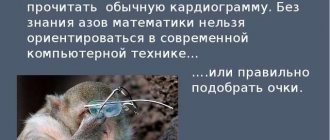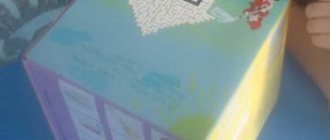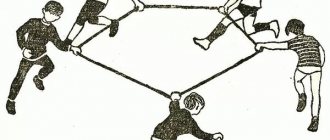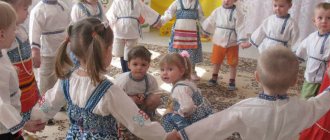Voskobovich's educational games in kindergarten gained popularity at the beginning of the century. Colorful kits with tools and a set of characters for conducting classes were among the first to be mass-produced in a factory version.
The author of the program, Vyacheslav Vladimirovich Voskobovich, made every effort to ensure that teachers understood his idea of the comprehensive development of thinking and creativity in a game with a fairytale edge. And although sets of Voskobovich’s games are sold in almost ready-made form, the author strongly advises introducing your own elements and heroes into the fairy tale, and using foreign objects for visualization. Thus, in the joint creativity of the child and the teacher, the basic skills of logical and creative thinking, reading, and counting will be taught unnoticed and smoothly.
Author
Vyacheslav Vladimirovich Voskobovich, an engineer and physicist from St. Petersburg, was puzzled by the search for educational toys for his own children in the early 90s.
The study of currently existing proposals did not yield anything - the range of domestic teaching material was extremely scarce, and international experience was practically not used.
Acquaintance with the experience of Zaitsev and Nikitins suggested the idea of creating a radically new system of classes, which would be not only useful, but also interesting for children, captivating and developing without forcing them to study. The main idea was to create tools for the comprehensive development of intelligence, logic, talent and personality in a playful way.
Voskobovich’s first games were “Geokont”, “Transparent Square”, “Folds”, “Two-Color Square”. appeared at the very beginning of the 90s. By 1997, the first training manual, “Little Geo, Raven Meter and I, Uncle Slava,” was written, which proposed combining classes with puzzles with a fairy tale twist that immerses the child in the story, giving an additional incentive to action and solving the problem.
In 1999, the author’s program “Fairy Tale Labyrinths of Games” was officially adopted and approved by the Education Committee of St. Petersburg. From now on, Voskobovich presents educational games in preschool educational institutions as an addition to activities that develop intellectual and creative thinking. By the beginning of the century, up to 90% of the city’s kindergartens used the method to one degree or another when organizing work with children.
Currently, the author of the system is the director of Voskobovich's Educational Games. The company and its tutoring center actively cooperate with the Union of Teachers of Russia and conduct training seminars free of charge, including in an online format in accordance with current reality.
Voskobovich's games for preschoolers and their descriptions are offered in sets designed for a certain age and are licensed. Buying an analogue is not encouraged, since the author himself believes that everything is taken into account in the original system. Exact adherence to the author's program, which teachers easily master, gives maximum results, despite the fact that within the framework of the game itself there is always a degree of unpredictable development. The child and the adult become co-creators.
How to play Voskobovich games
You need to carefully study the rules of the game and its fairy tale basis (after all, you will have to read the fairy tale or tell it to your parents). It is best to follow the methodological recommendations, complete the task one at a time, gradually complicating the game. There are parents who don't like to read instructions. They can play with the child as they please, and this will also be interesting and useful, but it is unlikely that the full potential of the game will be used.
If you are going to play Voskobovich’s games, it is better to purchase at least three games: educational, teaching reading and mathematics.
Voskobovich's games do not develop speech if the child plays them independently. Therefore, it is better to take part in his games and ask about the order and purpose of his actions, ask him to retell the plot of the fairy tale.
Games can be classified as board games (or “wall games”), so they do not contribute to the physical development of the child, but only to the intellectual and psychological. Parents themselves must take care of physical exercise. Remember that even a six-year-old child cannot concentrate on anything for more than 15 minutes.
Methodology
Each of Voskobovich's games has clearly defined pedagogical tasks and goals. But during the lesson, not only the child himself, but also the teacher disconnects from it. The kid helps decorate the boat with flags, arranges numbers from the album into the train cars, builds a magical web of strings, while gaining the most useful skills and knowledge for his age, from the development of fine motor skills, if we are talking about a 2-3 year old child, to solving equations. In most cases, the characters and environment are presented in the form of a construction set or mosaic. It will depend on the child himself how they will look in the process - this develops creative thinking, visual memory and a sense of taste.
General objectives of the development program:
- developing interest in the world around us, attention, memory, reducing attention deficit ratio, establishing trusting relationships with adults and playmates;
- developing research interest, creative thinking, and the ability to find non-standard solutions to situations;
- training of creative thinking, logical flexibility;
- psycho-emotional development, increased stress resistance, perseverance;
- practice of developing speaking, reading, and counting skills.
The plots and environments proposed by Voskobovich are only a support for conducting such classes. This is a multifunctional environment with secrets that the teacher himself can unexpectedly discover if he is sincerely interested in the process.
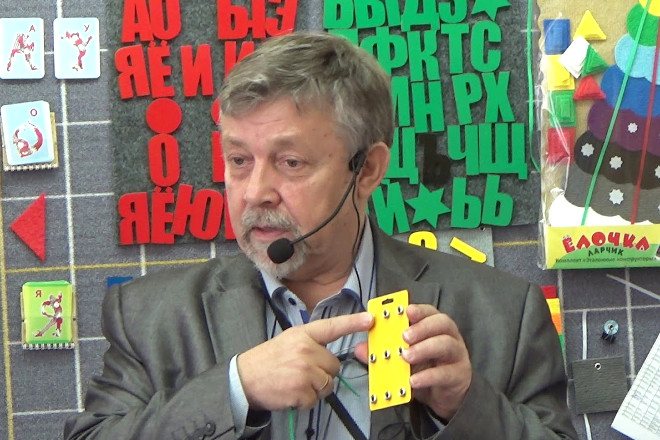
Voskobovich himself saw educational games only as part of the play process - the main activity of a child under the age of 7 years. His idea is to create a fairy-tale space in which the child will have to solve problems, but not imposed by the teacher, but arising as part of that fairy tale. This is exactly the kind of environment “The Violet Forest” should create as a fairy tale, for which the author created his unique characters:
- the wise raven Metro and the brave little Geo;
- invisible All and funny Magnolik;
- Digital Circus and Philemon Cotterfield;
- spider Yuk and the disappearing ice floes;
- Miracle Flower and Bee Zhuzha.
All objects that are offered to the child during the educational process are tied to and are part of this fairy tale. Thus, the tasks posed on Geokont, invented much earlier, began to be solved much more actively when, by the will of the author, it turned into the territory of the spider Yuka. It is more interesting for a child to place not abstract strings in accordance with the diagrams, but a magic web in a flower meadow. The creation process goes smoothly with pleasure from the task being solved - helping a specific character.
A universal sensorimotor environment allows activities to grow with the child. Using the same instrument, sometimes with replacement of its parts, the child learns first to identify colors, then to read and count, and then to solve complex logical algorithms.
The teacher in this story becomes a partner. The development of the plot also depends on it - only the basic elements are included with the tasks, which can be supplemented with available materials, developing both yourself and the child’s creative streak. The only condition for the implementation of the author's program remains a purple background, which stimulates creative thinking and creativity. It also allows you to abandon stereotypes in the display of elements from the first step.
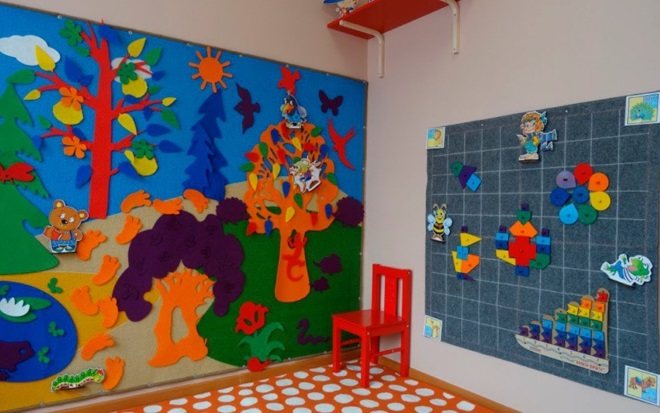
Games for children from 2 years old
Some games are suitable for children over two years of age. It's all about how to use the game. The main developmental task for babies 2-4 years old is the development of fine motor skills (movements of fingers and hands in general). There is a relationship between the development of fine motor skills and speech: the better the baby’s fingers, the better he speaks (and then writes). Most of Voskobovich's games develop fine motor skills. In the game "Geokont" you need to put rubber bands on pins, creating different shapes, in the game "Voskobovich Square" fine motor skills are developed due to the bends of the figure on a rigid fabric base. In the game “Plop-Plop Boat” you need to put rough multi-colored sails-flags on wooden stick masts; in the lacing games “Chamomile” and “Letter Constructor”, fine motor skills and different surfaces of objects are also involved. The game “Miracle Crosses” for this age is similar to large puzzles: shapes are made from colored parts. The game "Folds" contains a disk with songs. It develops the speech of children of this age. The games "Voskobovich's Cubes" and "Letter Constructor" give the first idea of letters.
Fairy tales
The main environment into which the teacher immerses the child is the purple forest and characters that change with the stages of growing up. Most loved by children:
- Lopushok is the first instructor in handling the proposed didactic materials;
- All is the hero of a transparent square, introducing geometric shapes, colors, letters;
- Kitten Timoshka from the Miracle Crosses set teaches children to see the difference in colors and shapes, compare and look for commonalities;
- Krutik Po - responsible for geometric shapes and spatial thinking.
The variety of heroes is huge - Lord Lucic, Crab Krabych from Miracle Island, Dwarves and Dolka. All of them are inhabitants of that same Violet Forest - a spatial-objective environment, divided into areas with their own specifics.
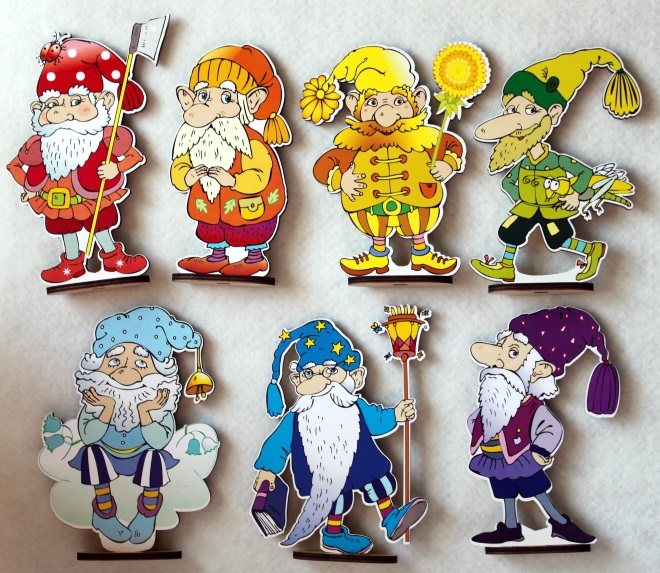
Many roles are spelled out. Dolka is a character who should introduce the child in a playful way to the concepts of parts and the whole, and smoothly lead to the study of fractions. In this case, the fractions will be presented on the same ready-made Flower figurine, from which you can take out and add petals. But even if during the game her role changes or the character leaves her clearing and appears somewhere in the area of the Mysterious Island or goes into space, which was not originally in the Violet Forest, the fairy tale will only benefit from this.
Technically, the characters are made of thick laminated cardboard or plywood and are equipped with at least two types of fastening - a magnet and Velcro. The latter allows you to mount the figure on the main display of the Carpet or any other textile surface, if the development of the scenario requires it. A magnet connects the part to metal displays or standard educational nurseries, which are equipped with preschool educational institutions. When purchasing a set for your own child, the characters can be purchased separately as they grow older.
Games that teach reading, sounds, letters
- Folding boxes . This game is based on the syllabic principle of Russian writing. It is a book, each spread of which is dedicated to all possible syllables with a certain consonant letter. On the same page there are pictures of animals and songs in which stressed syllables are highlighted. Folds are an improved syllabic alphabet. For the little ones there is a CD with songs included.
- Teremki Voskobovich. These are cubes based on the syllabic principle of Russian writing. The tower cubes are made of wood. There are 12 of them in total (2 of each color: white, gray, brown, purple, yellow, blue). Consonants are written on their edges. The tower cubes have windows. In these cubes you need to put cardboard chest cubes with vowels. Blue cubes for the letters A, O, U, E, Y, indicating the hardness of the consonants, green - for the letters Y, E, Yu, E, indicating the softness of the previous consonants. The same colors for hard and soft consonants are also preserved in folds.
Kids can play with the blocks as houses with windows. In each tower you can put pictures of animals (or small toys) on the letter drawn on the cube. To learn to read syllables, you need to put a chest cube in the tower cube, pronounce or sing the syllable.
- Funny letters . These are 10 cards representing vowels. They all depict Harlequin in different poses. They are called wittily: Harlequin, Urlekin, Orlekin, etc. They help develop imagination and remember the image of a letter.
- Reader on marbles . This is a square that you need to bend along the lines while reading the words. You can read up to 130 words.
- Lacing games for teaching reading: “Apple Tree”, “Snowman”, “Chamomile”. These are lacing of different shapes that connect letters into words. A child who does not know letters can play with them, just like lacing.
- The letter constructor introduces the “look” of each letter. There are rubber bands attached to the plywood base. Under these rubber bands, children insert the parts from which they make letters. There are 15 parts in total, different shapes. The creation of letters is accompanied by a fairy tale about adventures in the Violet Forest. It is the fairy tale that establishes the connection between letter and sound.
Preparation for classes
The technique is considered to be as comfortable and simple as possible for teachers to master. The leader of the process must himself study the material and the proposed characters, learn their main roles, wandering from one game to another. Then he introduces them to the children. You will also have to familiarize the child with the proposed tool - the rules for handling it, safety precautions. All parts and elements in factory kits are made taking into account the recommended age.
There are no ready-made scripts; you don’t have to read prepared stories. The teacher himself decides in what form to present the planned exercise, based on the roles of the characters. The child himself becomes an important co-author. And even if during the game the storyline is completely transformed, there is no problem.
During the lesson, the teacher must:
- constantly assess the level of difficulty, reduce or increase it relative to the recommended age level, depending on the child’s reaction;
- push and stimulate to solve a problem, without directly leading to a solution and without depriving the pleasure of emerging victorious from the battle;
- together with the child, come up with new rules and story lines, not succumbing to the desire to simplify to the basic;
- look for new forms and tools for developing the plot not according to the script;
- control the process and stop the lesson if the baby’s mood has deteriorated critically and interferes with further exercises.
The main task of the teacher is to maintain a trusting atmosphere between him and the child. From the outside it should seem like two people are solving the problem.
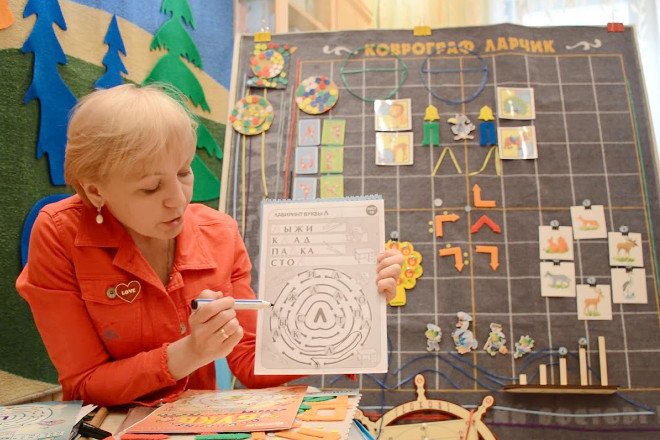
Games for children from 4-5 years old
All of the above games are also suitable for children of older preschool age, but they are played differently. The goal of this age: knowledge of the world and its laws in the game. The game "Geocont" gives an idea of colors, sizes and shapes, and teaches how to compare shapes by shape. The games “Voskobovich Square” and “Miracle Crosses” teach you how to create models using diagrams. The game "Plop-Plop Boat" gives an idea of the division of objects by color and quantity. The game “Folds” teaches you to divide a word into syllables and distinguish between vowels and consonants. The games “Chamomile”, “Snowman”, “Apple Tree” help with the help of lacing to form words from letters, and the game “Letter Constructor” makes it possible to remember the letters themselves. The game “Math Baskets” gives an idea of the composition of a number (you need to add mushrooms to the basket up to ten), prepares the pen for school (the child traces and shades, colors the mushrooms). The game “Teremki Voskobovich” is a unique simulator for teaching reading. The basis is syllables, not letters, as in traditional cubes.
The game "Reader on Balls" strengthens reading skills. Depending on the fold line, you can read short (2 letter) or long (6 letter) words (up to 130 words in the game). The game “Miracle Flower” gives the initial concept of fractions (parts of a whole) and teaches them to distinguish colors.
Advantages
Teachers using the methodology note two main advantages - an integrated approach to the development and education of children and the completeness of the proposed tools.
The game includes a developing subject environment for action, elements for manipulation, and complete instructions for an employee of an educational institution. This also helps parents who do not have a pedagogical education - they can get acquainted with the system within a couple of hours (study the manual or get acquainted with the recommendations for a specific game on the manufacturer’s website for free) and conduct a lesson with the child on their own.
The author himself insists that the merits of his system are the quality of children’s development:
- the emergence of the skill to receive and analyze information;
- development of creative thinking, reading and counting skills;
- the emergence of a model of behavior in society, empathy and compassion;
- formation of perseverance, desire to achieve goals, healthy persistence.
Moreover, everything happens in a playful, imperceptible form. The child simply plays, perceiving the didactic material as just another form of entertainment.
The quality of factory toys should also be noted. Materials approved by sanitary control authorities are used for production. When used in educational institutions, visual aids do not lose their appearance for a long time, even with regular sanitization. The content-rich environment is also transformable and completely safe.
Telling fairy tales using the square of V. V. Voskobovich
Aigul Zainutdinova
Telling fairy tales using a square by V.V. Voskobovich
Telling fairy tales using a game square by V. V. Voskobovich .
The game square consists of 32 rigid triangles glued to a flexible base on both sides. Thanks to this design the square can be easily transformed, allowing you to design both planar and volumetric figures. The square can be two or four colors.
By folding a square, you can introduce children to geometric shapes such as square , rectangle, triangle and their properties. By playing with a square, children develop imagination, attention, logic, thinking, and memory. Also, games with the Voskobovich square contribute to the development of children's speech. By playing the Voskobovich square, children compose their own story.
Our goal is to introduce children to the Voskobovich square ; develop thinking, imagination, speech using innovative technologies.
When we started working with the Voskobovich square, we focused on telling familiar fairy tales using the square (Teremok, Cinderella)
, and also invited the children to fantasize with
the square and compose their own fairy tale .
We started working with square B. V. Voskobovich from the middle group , but we believe that it can also be used for younger children. Working with square B. V. Voskobovich , we developed the imagination of children, giving them the opportunity to fantasize, we offer the beginning of a fairy tale , and the children continue it in turn. (for example: Once upon a time there was a square and one day he ended up in the forest) children begin to fantasize about what could happen the square In this way, imagination and speech develop, children become liberated and are not afraid that they will say that something is wrong, because this is their fairy tale .
In addition, children can compose their own fairy tale . Also, working with a square, we suggest telling an already familiar fairy tale , for example “Teremok”
in this case, we offer children diagrams for folding
a square . Children, when telling a fairy tale , put together a house , candy, etc. from a square. In this way, fine motor skills of the hands develop.
, mostly children tell familiar fairy tales using square B. V. Voskobovich , inventing and changing the plot of a fairy tale . Then continuing to work with square B. V. Voskobovich in the senior and preparatory school groups, we propose to come up with and tell a fairy tale about “Cinderella”
This is a familiar
fairy tale , children telling it can change the plot of the fairy tale . And then the children independently come up with and act out their own fairy tale using square B. V. Voskobovich . We introduced B squares . V. Voskobovich made with his own hands, two and four colors. Children have the opportunity to take squares and play them independently.
Game squares B. V. Voskobovich not only for telling fairy tales , but also in educational activities.
We consider the use of squares B. V. Voskobovich has a beneficial effect on the development of preschool children, helps develop imagination , thinking, fine motor skills, and speech.
“Fairytale lesson” or introduction to the fairy tale “Winged, Shaggy and Oily” using a transparent square by V. Voskobovich Purpose: To introduce children to the Russian folk tale “Winged, Hairy and Oily” and help them understand its meaning. Objectives: Educational: To introduce.
Summary of OOD on FEMP using educational games by V.V. Voskobovich in the middle group “Wonderful transformations of a square” on the topic: “Wonderful transformations of a square based on the fairy tale by V.V. Voskobovich “The Mystery of the Raven Meter, or the Tale of Amazing Adventures of Transformations.”
Summary of the game OOD on FEMP with the help of educational games by V.V. Voskobovich in the middle group “Journey to the Digital Circus” on the topic: “Journey to the Digital Circus” together with parents Goal: to attract the attention of parents to their intellectual and creative development.
Abstract of the GCD for FEMP “Dividing a square into two equal parts” Topic: “Dividing a square into 2 equal parts” Goal: developing in children positive motivation for learning, FEMP. Ability to divide a square into two.
Summary of a lesson on speech development “Teaching children to tell Russian folk tales using a matrix picture” Goal: developing the ability to tell a fairy tale using a matrix picture. Objectives: Educational: to develop children’s ability to tell stories.
Summary of a lesson on speech development “Teaching children to tell Russian folk tales using visual modeling” Department of Education of the Nizhny Novgorod City Administration Municipal budgetary preschool educational institution “Kindergarten.
Lesson summary “Three squares” “Three squares” Purpose: to teach children to correlate three objects by size and indicate their relationships with the words: “big”, small”, “medium”.
Telling and modeling fairy tales using mnemonic tables. OOD in the middle group “Fairy Tale Confusion” OOD – in the middle group “Fairy Tale Confusion” Telling and modeling fairy tales using mnemonic tables. Goal: Teach children to restore.
Development of mental abilities of children of senior preschool age with the help of games by V.V. Voskobovich Voskobovich's Square is an educational fairy tale for a preschooler. Most modern toys are disposable and useless, they are quick.
Lesson on FEMP. Topic: “In the country of square and triangle” Lesson on FEMP. Topic: “Journey to the land of squares and triangles” Purpose: to teach children to distinguish and correctly name a square and a triangle;
Source
Recommendations by age
Games and manuals are accompanied by descriptions indicating the recommended age. In practice, the same item can be used for an entire period of 2 to 7 years.
If a spider with a web of rubber bands teaches a two-year-old child the concept of colors and more or less, tones on the same basis, when preparing for school, the child can collect figures according to the abbreviation conceived by the teacher (route map) or solve the problem of inscribing an isosceles triangle into a square.
It all depends on the fairy tale proposed by the presenter. Even when using the same instrument in a group, you can change the difficulty of the lessons, going through the levels like in a computer game. The desire to reach the end or score extra points will be an additional incentive.
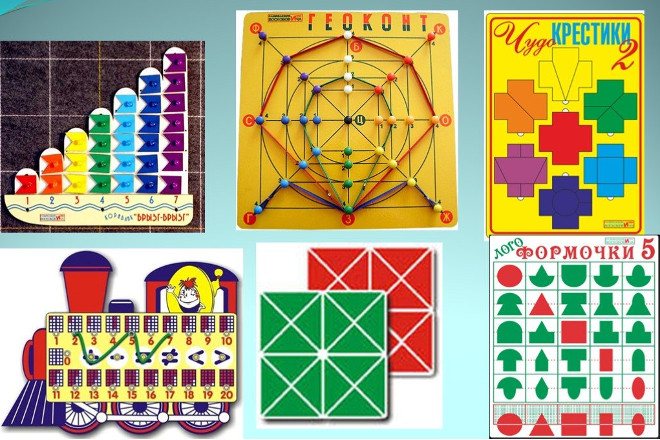
Games
The author suggests considering your games as a set of activities from 2 to 7 years old. But in practice, they can be used separately - most puzzles are independent and do not require additional investment. Buying a set is interesting only because of the variety of activities and the expanded possibilities of using each element.
"Purple Forest"
The main environment for conducting classes using the Voskobovich method. The carpet base makes it easy to move and place additional elements around the space, to which Velcro is attached. The basic equipment is designed to familiarize the child with the environment, study the seasons, and natural phenomena.
Set of basic parts corresponding to:
- trees and colorful leaves;
- clouds, sun and moon;
- the most popular animals of the forest;
- design for lake and forest areas.
On a carpet base, the teacher can attach both ready-made factory objects and characters, drawing the child into the game, and those made independently. You can involve your child in the process of inventing new stories and personalities. It is enough to attach Velcro to the craft so that the craft becomes an inhabitant of the purple forest.
As they grow older, the characters can change, and the space can turn from a forest into a preschooler’s room. Manufacturers offer to buy not only cardboard and wooden figurines for the Violet Forest, but also watches, technical devices and complex puzzles. The base remains the same. Recommended age: 2-7 years.
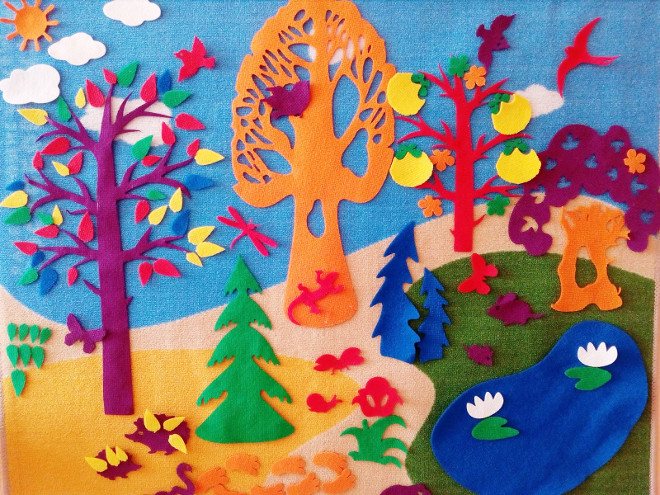
"Boat Plop-Plop"
Plastic boat with five multi-colored masts. The masts are perforated and consist of segments that are put on according to the pyramid principle. The game invites you to thread multi-colored strings through the holes - to study colors, shapes, and sizes in the game.
Attached to the independent kit is a training manual that contains the most popular author's puzzle tasks for the little ones. At the same time, parents can come up with an unlimited number of their own tasks or suggest that the child come up with a task for the teacher. Recommended age: from one year.
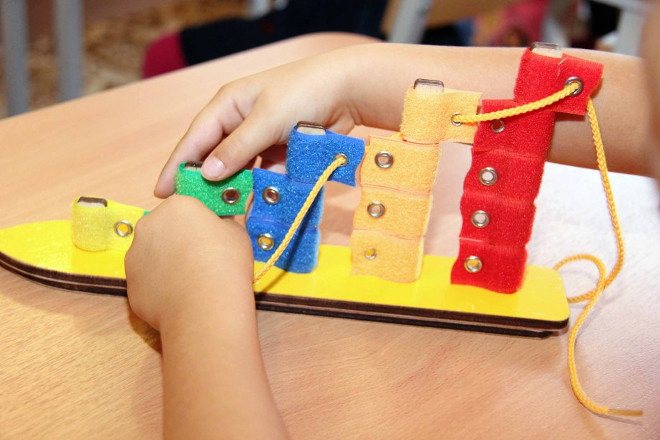
"Geocont"
Voskobovich's geokont is a plywood base with lacing supports attached to it. The supports are labeled, which allows you to give tasks to reproduce not only a specific drawing, but also a route along a kind of map with marked points. Colored elastic bands are included.
Based on Geokont Voskobovich, you can learn letters and numbers, teach spatial thinking (display objects from different sides and in mirrors), conduct creative activities on drawing with non-traditional materials. The author proposed several geocont options designed for different age groups. Age from 3 to 7 years.
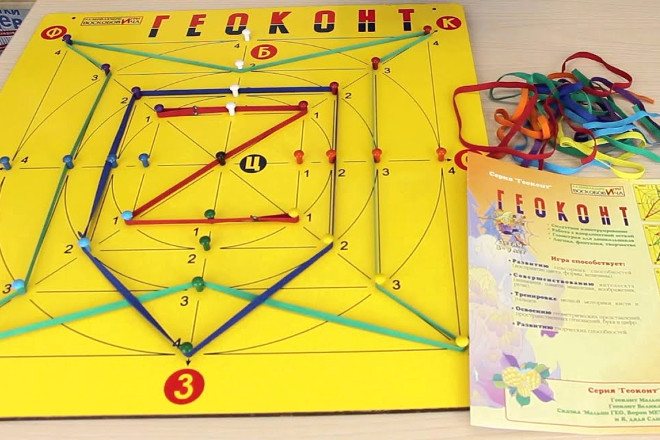
"Voskobovich Square"
Eternal origami is a puzzle made from laminated cardboard. The child will have to assemble shapes and objects from the red and green triangles applied to the base.
The game develops thinking, logic, and fine motor skills. A manual with assembly options is included in the kit. Recommended age: 2 to 7 years.
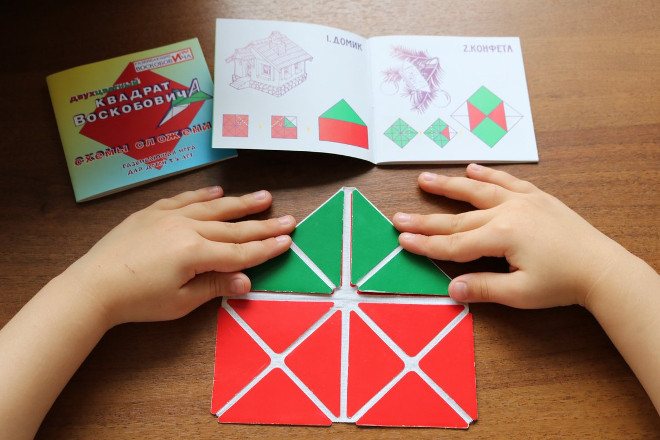
"Math baskets"
A number of activities can be carried out based on the set with numbers. Your helpers will be the Numbers from the Violet Forest, who collect mushroom numbers after the rain.
The child learns numbers and order, trains mental calculation and observation skills in a playful way. Additional elements of the Chest kit can be purchased separately, diversifying the process.
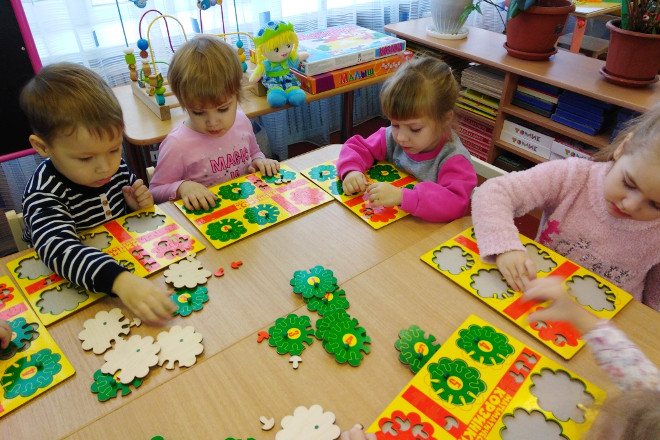
"Foldings"
A series of cards with short nursery rhymes, using which a child learns to read by syllables (words). In this game, the author modernized the popular method of teaching early reading by N. Zaitsev. The game is designed for children from 3 years old.
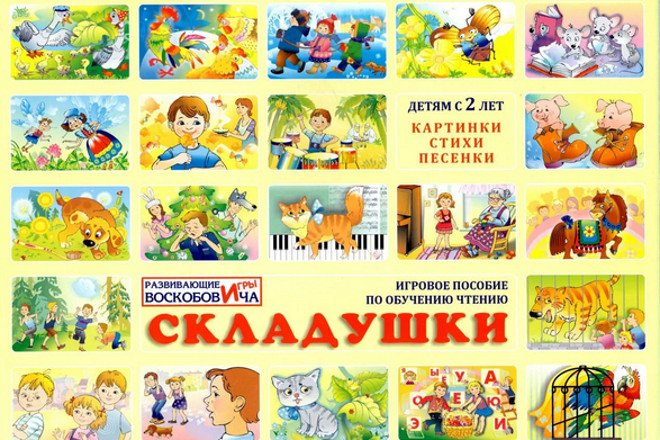
"Digital Circus"
The set is part of the Purple Forest, one of its zones. The director of the circus is Magnolik. He will introduce children to counting, shapes, and sizes. Children will compare and look for commonalities, and operate with simple mathematical operations.
Digital Circus additions:
- Flashlights - sizes, shapes, colors;
- Number constructor - introduction to mathematical concepts;
- Petals - concepts of color;
- Planet of multiplication - memorizing the table.
A manual with rules for organizing classes and popular supporting stories is included in the kit. Recommended age: from 3 years.
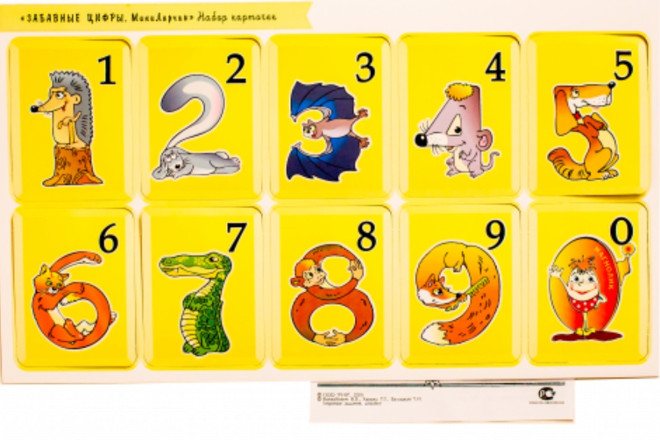
Disadvantages of Voskobovich's games
And there are no shortcomings. There are always children for whom a certain technique is not suitable. Voskobovich's games are suitable for everyone. And this can be explained: in preschool age, play is the main activity of a person; in play he lives, grows, develops and learns. Therefore, the game is suitable for everyone.
Children studying according to the Voskobovich method usually show a good level of development of memory, thinking, attention, as well as the ability to concentrate on the task at hand and bring it to the end. These children have a well-developed desire to learn and explore something new, which is important for the learning process at school.
Game aids
Tools for games from Voskobovich can be purchased separately or in sets. In the second case, there will be significant growth and diversity based on a single sensory environment. At the same time, the author himself recommends not dwelling on ready-made options, introducing your own characters, setting new tasks with the understanding that the child has outgrown the recommended ones.
All models and elements of didactic material are designed for multifunctional use. Fasteners, magnets, and Velcro allow the same characters to be transferred from one game to another, placed on a canvas or magnetic board, preventing the child from getting used to it and getting tired of the monotony.
With the creation of your own environment and technical additions, the situation is more complicated. Since 2013, the development center has hired professional artists who control not only the compliance of the color scheme of the manuals with the assigned tasks, but also the quality of product design.
Voskobovich's self-created games for preschoolers with their own hands are often inferior in quality and visual appeal to the eyes of factory-made kits. Children who are demanding about wrappers are not always ready to accept a replacement. But the final decision remains with the teacher and parent. Even partial application of Voskobovich’s methods in the learning process has a positive effect on the result and dynamics of work.
With the abundance of educational games nowadays, Voskobovich’s technique has not lost its relevance. Curricula are actively used by preschool teachers and can be implemented by parents themselves. The simplicity and fun of the system allows you to do this. The company's team, under the leadership of its founder, periodically updates the range of benefits and offers new forms that take into account the interests of modern children.
How are classes conducted using the Voskobovich method?
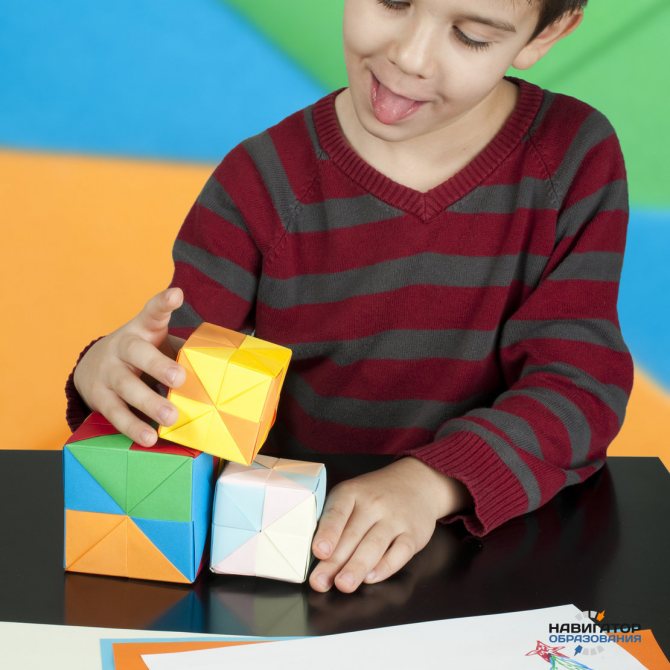
Before starting classes, be sure to read the methodological recommendations and instructions for the Voskobovich game that you bought for your baby. It is very important not to force your child to complete certain tasks in the game. The child must determine the pace and level of load himself, independently switching from one task to another.
Since Voskobovich’s games assume that the child will sit in one place for some time, the author of the technique advises that at first, classes should last about 10 minutes. After a short break, when the child runs around a little, you can return to completing tasks.
Voskobovich's fairytale method is built on trusting and friendly relationships between the child and parents, when adults and children are partners and support and help each other in everything. Therefore, if your child doesn’t succeed in something the first time, there is no need to criticize him. Praise your child more often, and rejoice at his every victory (even if it is insignificant).
In the process of completing tasks, children almost all the time work only with their hands and interact very little with the environment. In order for the child to develop not only memory, logic, thinking, motor skills, etc., but also speech, Vyacheslav Vadimovich Voskobovich recommends asking the child to comment on all his actions or retell the plot of a fairy tale. Ask your child as many questions as possible about what fairy-tale task he is performing now, and what options for completing it he has already come up with.
